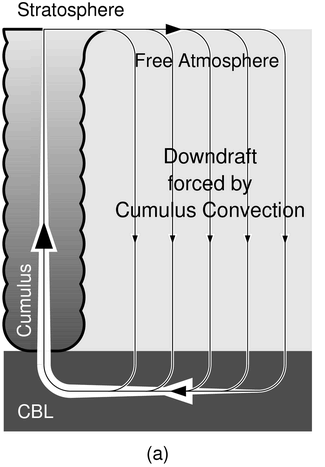
What Is Dynamical Detrainment < rdctheory.cloud
[NOTE]
This article is based on our interpretation for the Dynamical Detrainment (DD).
The interpretation might be old,
because we have not updated our understanding on DD
due to lack of research environment.
However, unless there have been very drastic changes in the DD constitution,
the following statements would be still correct.
Although we do not follow the latest developments in the Dynamical Detrainment (DD) implementation, it is easy to imagine that there must be a great many variants of DD. And it is impossible to explain all those variants in detail. For the uninitiated, therefore, we will outline here the simplest chimney-type convective motion, which is a common concept for DD.

An air parcel near the surface is supplied with heat and water vapor from the surface, becomes lighter than its surroundings, gains buoyancy, and begins to rise. At higher altitudes in the troposphere, the temperature is lower, and therefore the saturated water vapor content is also lower. When a rising air parcel exceeds a certain altitude, the amount of water vapor in the air parcel exceeds the saturated water vapor content at that altitude, and the excess water vapor in the air parcel condenses into water or ice. In reality, complex cloud microphysical processes are at work, but a rough understanding is that the oversaturated water vapor condenses and falls as precipitation (rain, hail, snow, etc.) and is removed from the air parcel. In this way, in the rising air parcel, the absolute humidity (water vapor mixing ratio) decreases progressively while the relative humidity remains at 100%.
As the air pressure is lower for higher altitude, the air parcel decreases its temperature due to adiabatic cooling/expansion (in more complex models, the temperature/humidity in the air parcel also decreases due to entrainment of cool, dry air around the cumulus). The buoyancy of the air mass is gradually lost in this way, and when it reaches an altitude of zero buoyancy, it can no longer continue its upward motion. Other ascending air parcels also lose buoyancy at similar altitudes, but since air cannot continue to accumulate, it is pushed horizontally. Here, it is assumed that the air parcel needs a forcing such as buoyancy to move vertically, but is free to move horizontally at the same altitude (IGNORING thermodynamical effects in the clear-sky area due to the dynamical forcing). Such horizontal outflow from a cumulus cloud at the altitude of zero buoyancy is called DD. Just as outgoing air parcels at the top of the cumulus are pushed horizontally by the upward flow in cumulus clouds, air parcels in the clear-sky area are also pushed downward. Such a downdraft will occupy the clear-sky region outside the cumulus cloud. It undergoes adiabatic heating/compression, providing a temperature increase, but at the same time it also undergoes radiative cooling, which becomes balanced with the dynamical heating, thus achieving a kind of (namely, DYNAMICALLY-FORCED) radiative-convective equilibrium state.
It is important to note that the amount of water vapor in the air occupying the vast clear-sky area is determined by the amount of saturated water vapor at the altitude of zero buoyancy. Since no phase change of water occurs in the downward flow, the mixing ratio of water vapor in the air parcel is kept at a constant value. At lower altitudes, where the temperature rises, the relative humidity becomes lower. This chimney-type circulation makes the entire atmosphere desiccated, especially in the lower atmosphere. However, it does not match the humidity of the real atmosphere.
Dynamically, if the downward flow is allowed only from cloud tops, the air parcels in the forced downward flow will rise the temperature according to dry adiabatic heating/compression, creating a difference between the temperature inside the cumulus (with MOIST adiabatic temperature lapse rate) and the temperature outside the cumulus (determined by the downward mass flux which is balanced with the upward mass flux in the cumulus, DRY adiabatic temperature lapse rate, and radiative cooling rate) at the same altitude. ([NOTE] In some cases the temperature outside the cumulus will be even higher than the temperature inside the cumulus, which is impossible because cumulus has negative buoyancy. But this is not the only problem. Any steady temperature difference is impossible.) The steady temperature difference must be maintained in the chimney-type convection model. To achieve this, steady convective motion must be maintained. However, the Earth's atmosphere cannot meet such a requirement. The duration of cumulus clouds is short (about one hour) and the time interval of cumulus cloud development is long (much longer than one hour). Within the long quiet interval period, no convective forcing should occur and the horizontal temperature difference should dissipate. Therefore, the steady temperature difference cannot be maintained.
As noted at the top of this page, various improvements and attempts have been made to DD to overcome these difficulties. For example, ensemble of convections with different altitudes of zero buoyancy have been considered, or other physical processes and flows have been introduced. We believe, however, that these problems associated with DD are intrinsic to the structure of DD itself, and that the only way to represent the real atmosphere is to introduce a fundamentally different concept of RDC.
What Is Dynamical Detrainment < rdctheory.cloud
Exhibited on 2023/02/17
Last updated on 2023/10/09
Copyright(C)2022-2023 jos <jos@kaleidoscheme.com> All rights reserved.